Next-generation technology in small-scale LNG has potential to reshape the global shipping-fuels industry. Especially after IMO 2020 sulphur regulations, LNG should compete with diesel. Opportunities in trucking and shale are less clear-cut.
This note outlines the technologies, economics and opportunities for LNG as a transport fuel, following a three-month investigation.
- Why technology matters. Pages 2-4 of the note describe incumbent technologies in small-scale LNG, and the need for superior solutions.
- The cutting edge . Pages 5-7 draw on patents and technical papers to describe next-generation technologies, at the cutting edge of small-scale LNG. We model that they are economic. They can can provide LNG to the market at $10/mcf.
- Potential to transform shipping-fuels. Pages 9-13 find strong economic upside for novel LNG technologies in the shipping industry, with potential to create 40-60MTpa of incremental LNG demand, looking across the global shipping fleet.
- Less positive on LNG as a trucking fuel. Pages 14-15 explain why the economics are more challenging for LNG use in land-transportation, i.e., trucking.
- Less positive on LNG use in shale. Page 16 explains, similarly, why LNG is less advantageous in the shale patch than converting rigs and frac spreads to piped gas.
- Other technologies. Page 17 notes other companies with interesting offerings in small-scale LNG liquefaction, including advances by Exxon and Shell.
Have further questions? Please contact us and we’ll be happy to help: [email protected]
